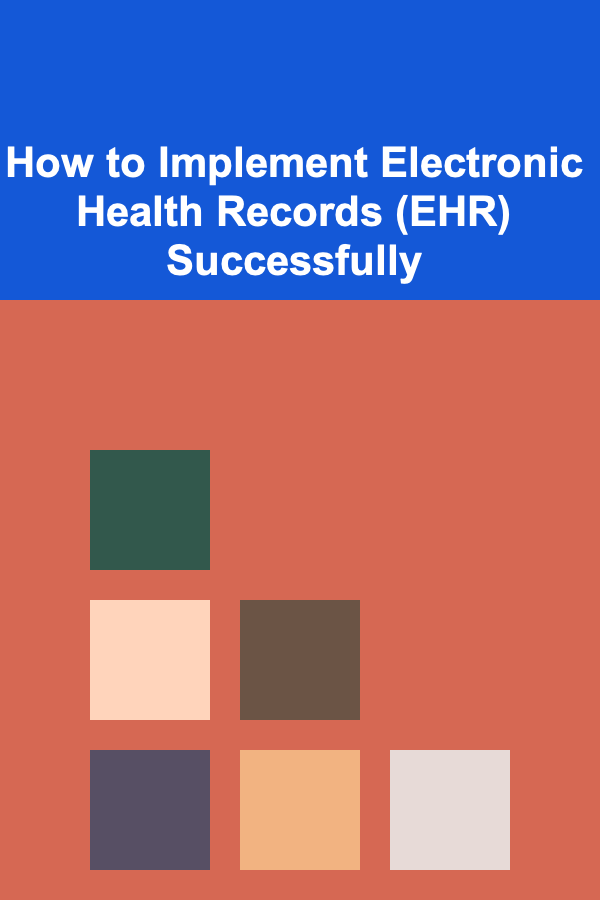
How to Implement Electronic Health Records (EHR) Successfully
ebook include PDF & Audio bundle (Micro Guide)
$12.99$9.99
Limited Time Offer! Order within the next:

Electronic Health Records (EHR) systems have revolutionized the healthcare industry, offering a powerful tool to improve patient care, streamline operations, and reduce costs. However, the successful implementation of an EHR system is a complex and challenging task that requires careful planning, coordination, and execution. As healthcare providers move from paper-based systems to digital records, the transition must be managed with precision to ensure that the benefits of EHR systems are realized while minimizing disruptions to patient care and daily operations.
This article will explore the key strategies and best practices for successfully implementing EHR systems, focusing on the steps involved, the challenges faced, and how to overcome them. With the right approach, healthcare organizations can leverage the full potential of EHR systems to improve patient outcomes, increase operational efficiency, and ensure regulatory compliance.
Define Clear Objectives and Goals
The first step in implementing an EHR system is to define clear objectives and goals for the project. This is essential for guiding the decision-making process and ensuring that the implementation is aligned with the organization's strategic vision. The goals may vary depending on the size and type of healthcare facility, but typical objectives include:
- Improving Patient Care: EHR systems can enhance the quality of patient care by providing accurate and up-to-date information at the point of care, reducing errors, and improving communication between healthcare providers.
- Increasing Operational Efficiency: Streamlining administrative processes, such as patient scheduling, billing, and documentation, can lead to significant cost savings and productivity gains.
- Ensuring Regulatory Compliance: EHR systems are designed to comply with regulations such as the Health Insurance Portability and Accountability Act (HIPAA) and Meaningful Use, ensuring that healthcare providers meet legal requirements for patient data privacy and security.
- Facilitating Data Sharing and Interoperability: EHR systems enable healthcare providers to exchange patient information securely, leading to better coordination of care and reducing the risk of duplicated tests or procedures.
It is essential to involve key stakeholders---such as healthcare providers, administrators, IT staff, and patients---in the goal-setting process to ensure that the system meets the needs of all parties.
Assess Organizational Readiness
Before implementing an EHR system, it is crucial to assess the organization's readiness for change. This assessment involves evaluating various aspects of the organization, including infrastructure, staffing, and existing workflows. A thorough readiness assessment will help identify potential obstacles and gaps that could hinder the implementation process.
Key areas to assess include:
- Technology Infrastructure: Evaluate whether the existing hardware and network infrastructure can support the EHR system. This includes assessing the capacity of servers, workstations, and internet connectivity. Consideration should also be given to cloud-based versus on-premise EHR solutions.
- Staff Training: Staff readiness is a critical factor in the success of an EHR implementation. Determine whether staff members have the necessary skills and knowledge to use the new system effectively. If not, plan for comprehensive training and support.
- Workflow Assessment: EHR implementation will often require changes to existing workflows. Conduct a thorough review of current clinical and administrative processes to identify areas that may need adjustment. Engaging staff in this process can help identify pain points and improve adoption.
- Financial Resources: EHR systems can be costly, and healthcare organizations must ensure they have the financial resources to support the implementation and ongoing maintenance. This includes costs for hardware, software, training, and IT support.
A readiness assessment provides valuable insights into the preparedness of the organization and helps to set realistic expectations for the implementation process.
Choose the Right EHR Vendor
Choosing the right EHR vendor is one of the most critical decisions in the implementation process. The right vendor will provide the tools and support necessary to meet the organization's goals, while the wrong vendor may lead to costly delays and disruptions.
When evaluating EHR vendors, consider the following factors:
- System Features and Capabilities: The EHR system should meet the specific needs of your healthcare organization. It should have features that align with your goals, such as patient scheduling, clinical documentation, billing, and patient portal integration.
- Customization and Flexibility: Healthcare organizations vary in size, complexity, and specialty. The EHR system should be flexible enough to accommodate the unique needs of your practice, whether it's a small family practice or a large hospital system.
- Interoperability: The EHR system should be able to integrate with other systems, such as laboratory information systems, radiology systems, and pharmacy management tools. This will facilitate data sharing and improve coordination of care.
- User-Friendliness: A user-friendly interface is essential to ensure that healthcare providers can navigate the system efficiently. Systems that are intuitive and easy to use will result in better adoption and reduce the likelihood of errors.
- Support and Training: The vendor should provide ongoing support and training to ensure that staff can use the system effectively. Adequate training is critical to the success of the implementation process.
- Cost and Value: While cost is an important consideration, it should not be the only factor. It is essential to weigh the total cost of ownership, including licensing fees, hardware, training, and ongoing support, against the potential benefits the system will provide.
Taking the time to evaluate and select the right vendor will help ensure that the EHR system meets the needs of the organization and contributes to its long-term success.
Involve Stakeholders in the Planning Process
Successful EHR implementation requires the involvement of a wide range of stakeholders, including healthcare providers, administrators, IT staff, and patients. Involving stakeholders early in the planning process helps ensure that the system meets their needs and that they are committed to the project.
Some key stakeholders to include in the planning process are:
- Clinical Staff: Physicians, nurses, and other clinical staff are the primary users of the EHR system. Their input is essential to ensure that the system supports their workflow and provides the tools they need to deliver high-quality patient care.
- Administrative Staff: Administrative staff, such as receptionists, billing specialists, and IT personnel, will also interact with the EHR system. Their feedback is critical to ensure that the system streamlines administrative tasks and improves operational efficiency.
- IT Department: The IT department plays a central role in the implementation process, providing technical expertise and ensuring that the system is properly integrated with existing infrastructure. Their involvement is critical in troubleshooting technical issues and providing ongoing support.
- Patients: Patient engagement is becoming increasingly important in healthcare. Involve patients in the process by providing them with a patient portal that allows them to access their health information, schedule appointments, and communicate with healthcare providers.
By involving stakeholders from the outset, healthcare organizations can ensure that the EHR system meets the needs of all parties and that there is broad support for the project.
Develop a Detailed Implementation Plan
A detailed implementation plan is essential to guide the successful deployment of an EHR system. The plan should outline the steps involved in the implementation process, including timelines, milestones, and responsibilities. A well-thought-out implementation plan helps ensure that the project stays on track and that potential issues are addressed proactively.
The implementation plan should include:
- Timeline and Milestones: Establish a realistic timeline for the implementation process, with clear milestones to track progress. The timeline should account for all phases of the project, from initial planning and vendor selection to system testing, training, and go-live.
- Resource Allocation: Identify the resources needed for the implementation, including staff, technology, and budget. Allocate resources to ensure that the project stays on schedule and within budget.
- Risk Management: Identify potential risks and challenges that could impact the implementation, such as technical issues, resistance to change, or delays in training. Develop strategies to mitigate these risks and ensure that the project stays on track.
- Testing and Pilot Programs: Prior to full implementation, conduct thorough testing of the system to ensure that it works as expected. A pilot program can be used to test the system in a controlled environment and identify any issues before going live.
A detailed implementation plan provides a roadmap for the EHR project and helps ensure that all stakeholders are aligned and working toward the same goals.
Provide Comprehensive Training and Support
One of the most critical factors in the success of EHR implementation is training. Healthcare providers and staff must be fully trained on how to use the new system to ensure that it is adopted successfully. Training should be comprehensive, ongoing, and tailored to the needs of different user groups.
Key elements of a successful training program include:
- Role-Based Training: Provide training that is specific to the role of each user group. For example, physicians and nurses may need training on clinical documentation, while administrative staff may need training on scheduling and billing.
- Hands-On Training: Provide opportunities for users to practice using the system in a hands-on environment. This will help build confidence and ensure that users are comfortable with the system before it goes live.
- Ongoing Support: EHR implementation does not end with initial training. Ongoing support is essential to address any issues that arise after the system is deployed. This may include helpdesk support, online resources, and regular refresher training sessions.
Comprehensive training and support ensure that users can effectively use the system, leading to greater adoption and improved patient care.
Monitor and Evaluate the System
Once the EHR system is live, it is essential to monitor and evaluate its performance to ensure that it is meeting the organization's goals. Regular monitoring allows for the identification of any issues or areas for improvement, while ongoing evaluation ensures that the system continues to meet the needs of the organization as it evolves.
Key metrics to track include:
- System Performance: Monitor the system's performance to ensure that it is running smoothly and that users are not experiencing technical issues, such as slow response times or system crashes.
- User Satisfaction: Conduct surveys or interviews with users to assess their satisfaction with the system and identify any challenges they are facing. This feedback is valuable for making improvements and addressing issues.
- Patient Outcomes: Evaluate the impact of the EHR system on patient care, such as reductions in medication errors, improvements in care coordination, or better clinical decision-making.
- Operational Efficiency: Track the impact of the system on administrative tasks, such as billing, scheduling, and documentation. Look for improvements in efficiency and reductions in errors or delays.
Monitoring and evaluation allow healthcare organizations to continuously improve the system and ensure that it delivers the expected benefits.
Address Challenges and Overcome Resistance
The implementation of an EHR system is not without challenges. Resistance to change, technical issues, and workflow disruptions are common obstacles that organizations must address during the implementation process.
To overcome these challenges:
- Communicate the Benefits: Clearly communicate the benefits of the EHR system to all stakeholders, highlighting how it will improve patient care, reduce errors, and increase efficiency. Address any concerns and involve staff in the decision-making process.
- Provide Change Management Support: Change can be difficult, particularly for staff who are accustomed to traditional paper-based systems. Implement a change management strategy that includes regular communication, training, and support to help staff transition smoothly.
- Address Technical Issues: Ensure that technical issues are addressed promptly by having IT staff available to troubleshoot and resolve problems quickly. Regular system updates and maintenance are also necessary to keep the EHR system functioning optimally.
By addressing challenges proactively and providing support throughout the process, healthcare organizations can minimize disruptions and ensure a successful EHR implementation.
Conclusion
Implementing an Electronic Health Record system is a significant undertaking that requires careful planning, coordination, and execution. By following the steps outlined in this article---defining clear objectives, assessing organizational readiness, choosing the right vendor, involving stakeholders, developing a detailed implementation plan, providing training and support, monitoring performance, and addressing challenges---healthcare organizations can achieve a successful EHR implementation that improves patient care, enhances operational efficiency, and ensures regulatory compliance.
Reading More From Our Other Websites
- [Needle Felting Tip 101] Mastering Needle Felting: How to Choose and Use the Perfect Mold
- [Hiking with Kids Tip 101] Hidden Trail Gems: Off-the-Beaten-Path Hikes Kids Will Love
- [Organization Tip 101] How to Organize Your Nightstand for Better Sleep
- [Personal Care Tips 101] How to Experiment with Aftershave Scents to Find the Best Match for You
- [Home Space Saving 101] How to Maximize Vertical Storage Ideas for Small Apartments
- [Home Family Activity 101] How to Implement Tech-Free Evenings for Quality Time
- [Personal Finance Management 101] How to Plan for Major Expenses (e.g., Buying a Home, Paying for College)
- [Skydiving Tip 101] Best Skydiving Training Programs: Choosing the Right Certification for Your Goals
- [Home Security 101] How to Use Smart Lighting to Deter Burglars from Targeting Your Home
- [Personal Investment 101] How to Choose Between Individual Stocks and Mutual Funds

How to Make Money Online as an Executive Assistant: 10 Actionable Ideas
Read More
How to Set Up a Task Management System that Works for You
Read More
The Social Worker's Toolkit: Essential Skills for Empowering Individuals and Families
Read More
How To Master Extreme Kayaking in Rapids
Read More
How to Make Perfect Hard-Boiled Eggs
Read More
How to Develop Climate-Smart Forestry
Read MoreOther Products

How to Make Money Online as an Executive Assistant: 10 Actionable Ideas
Read More
How to Set Up a Task Management System that Works for You
Read More
The Social Worker's Toolkit: Essential Skills for Empowering Individuals and Families
Read More
How To Master Extreme Kayaking in Rapids
Read More
How to Make Perfect Hard-Boiled Eggs
Read More